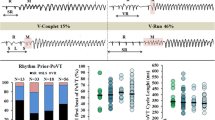Summary
Ventricular fibrillation (VF) which is normally sustained in large animals and humans, is transient in small animals. The purpose of the present study was to evaluate the possible effect of changing cardiac rate on spontaneous ventricular defibrillation.
In isolated perfused rat heart, VF was electrically induced during normal spontaneous rhythm of the heart at normal rate and at various ventricular pacing rates. It was found that:
-
1)
Electrically induced VF in isolated perfused, non-ischemic rat heart spontaneously terminated in 88% of the hearts;
-
2)
Ventricular pacing rhythm of spontaneous rate plus 10% caused VF to be sustained in 26% of the hearts (which defibrillated spontaneously during normal rates);
-
3)
Ventricular pacing at 200% of the basic rate led to sustained VF in about half the VF episodes (14 out of 33, p<0.005). In the remainder, which defibrillated spontaneously, a sustained VF could be achieved by further increase in ventricular pacing rate;
-
4)
Slow pacing rate, as a result of the surgical production of atrioventricular (A-V) block, enhanced the probability of spontaneous defibrillation (21 of 21 episodes after slow pacing vs 24 of 34 episodes following pacing at previous normal sinus rhythm, p<0.05).
Selective modulation of conduction velocity, refractory period or both, achieved by changes in ventricular pacing rate was assumed to play an important role in determining whether electrically-induced VF would be transient or sustained.
Similar content being viewed by others
References
Amitzur G, Manoach M, Weinshtock M (1984) The influence of cardiac cholinergic activation on the induction and maintenance of ventricular fibrillation. Basic Res Cardiol 79:690–697
Bacaner M (1971) Experimental and clinical effects of bretylium tosylate on ventricular fibrillation, arrhythmias and heart block. Geriatrics 26:132–148
Boyett MR, Fedida D (1984) Changes in the electrical activity of dog cardiac purkinje fibers at high heart rates. J Physiol 350:361–391
Bredikis J, Bukauskas F, Veteikis R (1981) Decreased intercellular coupling after prolonged rapid stimulation in rabbit atrial muscle. Circ Res 49:815–820
Buckberg GD, Hottenrott CE (1975) Ventricular fibrillation. Its effect on myocardial flow, distribution and performance. Ann Thor Surg 20:76–85
Crampton R (1980) Accepted, controversial and speculative aspects of ventricular defibrillation. Prog in Cardiovasc Dis 23:167–186
Gilmore JP, Gerlings ED, Bregman R (1974) Potassium balance and potentiation phenomena in the rat heart. Am J Physiol 226:45–49
Guss SB, Kastor JA, Josephson ME, Scharf DL (1976) Human ventricular refractorines. Effects of cycle length, pacing site and atropine. Circulation 53:450–455
Han J, Millet D, Chizzonitti B, Moe GK (1966) Temporal dispersion of recovery of excitability in atrium and ventricle as a function of heart rate. Am Heart J 71:481–487
Hoffman BF, Sucking EE, Brooks CM (1955) Vulnerability of the dog ventricle and effects of defibrillation. Circ Res 3:147–151
Josephson ME, Spielman SR, Greenspan AM, Horowitz LN (1979) Mechanism of ventricular fibrillation in man. Am J Cardiol 44:623–631
Kannengiesser GI, Lubbe WF, Opie LH (1975) Experimental myocardial infarction with left ventricular failure in isolated perfused rat heart. Effects of isoproteranol and pacing. J Mol Cel Cardiol 7:135–151
Kent KM, Smith ER, Redwood DR, Epstein SE (1972) The deleterious electrophysiological effects produced by increasing heart rate during experimental coronary occlusion (Abs). Clin Res 20:379
Lubbe WF, Bricknell OL, Marzagao C (1975) Ventricular fibrillation threshold and the vulnerable period in the isolated perfused rat heart. Cardiovasc Res 9:613–620
Lubbe WF, Daries PS, Ophie LH (1978) Ventricular arrhythmias associated with coronary artery occlusion in the isolated perfused rat heart: a model for assessment of antifibrillatory action of antiarrhythmic drugs. Cardiovasc Res 12:212–220
Lubbe WF, Muller CA, Worthington M, McFadyen EL, Opie LH (1981) Influence of propranolol isomers and atenolol on myocardial cyclic AMP, high energy phosphates and vulnerability to fibrillation after coronary artery ligation in the isolated rat heart. Cardiovasc Res 15:690–699
Manoach M (1984) Factors influencing maintenance and spontaneous termination of ventricular fibrillation. Internat J Cardiol 5:398–402
Manoach M, Kauli N, Netz H, Beker B, Asael M (1979) Dibenzepin as an antifibrillatory agent for spontaneously terminating electrically induced ventricular fibrillation. Israel J Med Sci 15:443–447
Manoach M, Netz H, Erez M, Weinshtock M (1980) Ventricular self-defibrillation in mammals: age and drug dependence. Age and Aging 9:112–116
Manoach M, Wyatt RF (1984) Intracellular myocardial recordings in vivo during sustained and transient ventricular fibrillation. In: d'Alche P. Advances in electrocardiology (Proceedings on the Xth international congress on electrocardiology). Centre de publications de l'université de Caen: 401–403
Nishimura M, Watanabe Y (1983) Membrane action and catecholamine release action of bretylium tosylate in normoxic and hypoxic canine purkinjc fibers. J Am Coll Cardiol 2:287–295
Obeid AI, Verrier RL, Lown B (1978) Influence of glucose, insulin and potassium on vulnerability to ventricular fibrillation in the canine heart. Circ Res 43:601–608
Opie LH (1965) Coronary flow rate and perfusion pressure as determinants of mechanical function and oxidative metabolism in isolated perfused rat heart. J Physiol 180:529–541
Paul MH, Theilen EO, Gregg DE, Marsh JB, Gasten GG (1954) Cardiac metabolism in experimental ventricular fibrillation. Circ Res 2:573–578
Sano T (1976) Mechanism of cardiac fibrillation. Pharmacol & Ther 2:811–842
Spach MS, Kootsey JM, Sloan JD (1982) Active modulation of electrical coupling between cardiac cells of the dog. Circ Res 51:347–368
Spear JF, Moore EN, Horowitz LN (1973) Effect of cardiac pulses delivered during the ventricular vulnerable period upon the ventricular fibrillation threshold. Am J Cardiol 32:814–822
Surawicz B (1971) Ventricular fibrillation. Am J Cardiol 28:268–287
Wiggers C (1940) The mechanism and the nature of ventricular fibrillation. Am Heart J 20:399–412
Zipes DP (1975) Electrophysiological mechanisms involved in ventricular fibrillation. Circulation (suppl I) 52:III 120–130
Author information
Authors and Affiliations
Rights and permissions
About this article
Cite this article
Arad, M., Rogel, S., Mahler, Y. et al. The effect of heart rate on the termination of electrically induced ventricular fibrillation in the isolated perfused rat heart. Basic Res Cardiol 83, 678–686 (1988). https://doi.org/10.1007/BF01906963
Received:
Issue Date:
DOI: https://doi.org/10.1007/BF01906963




